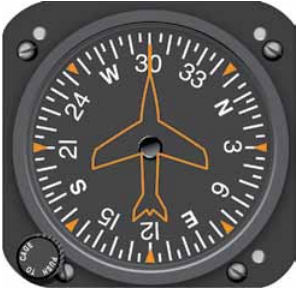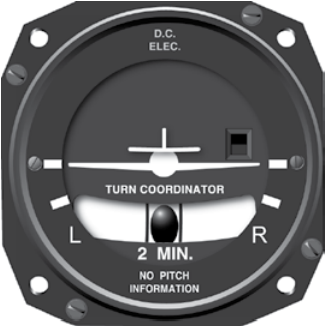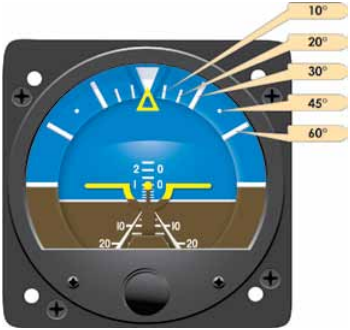OSUN, Where Art Thou... Going?
While my flight instructor Martin and I were working with the autopilot last weekend, we also spent some time working on flying with a partial panel. This practice is intended to simulate the failure of one or more instruments on the panel. For this particular “failure,” we simulated losing the directional gyro and attitude indicator by applying round covers that obscured the instrument faces. These are gyroscopic instruments that rely on a vacuum pump to operate, so we were essentially simulating a vacuum pump failure.

The directional gyro or heading indicator is the primary instrument used to determine bank. It basically tells you if you’re flying straight or if you’re in a turn. If you’re in a turn it tells you which direction you’re turning and roughly how fast you’re turning. Of the instruments in the standard “six pack” (air speed, attitude, altimeter, turn coordinator, heading, vertical speed) two provide supporting bank bank information.

The turn coordinator will tell you which direction (left or right) you’re turning and relatively how quickly you’re turning. The turn coordinator above (and most for that matter) indicates a 2 minute standard rate turn in either direction when the left or right wing tip of the miniature airplane is aligned with the tick marks below center on either the right or left sides. With the miniature wing tip aligned with one of those ticks, it will take 2 minutes to turn a full 360°.

That attitude indicator is also a supporting bank indicator and unlike the turn coordinator, it is a supporting indicator of pitch. Of course this is a moot point because we’ve lost our vacuum pump so our attitude indicator is no longer usable. We haven’t lost any of our primary pitch indicators (airspeed, altimeter, or vertical speed indicator) but we have lost our primary bank indicator and our “six pack” is only going to tell us how fast we’re turning and in which direction we’re turning (left or right), it won’t tell us where we’re heading. Fortunately for us, one of the most primitive instruments in the plane, our friend the magnetic compass can tell us that information.
I was going to describe the compass as one of the most “reliable” instruments in the plane and it probably is, but it was also one of the first things I had to replace when I purchased my plane. I originally had a “wet” compass (also known as a “whiskey compass”) that had a compass card suspended in mineral oil. Shortly after taking off with some friends one day, I felt something drip on the back of my hand. In my airplane, all the fuel is stored in the wings above our heads with fuel lines crossing over the cabin. My initial thought was that we were leaking 100 octane fuel into the cabin. After a quick sniff and touch I realized it was mineral oil leaking from the compass… phew! I had the leaky compass replaced with a vertical card compassthat’s not only easier to ready but also requires no fluid.
So, there we go, I can just use my fancy new compass as a direct replacement for my lost heading indicator. While on a easterly heading, my instructor directed me to turn to a heading of 360° (North). After lifting the left wing to clear for traffic, I initiated a standard rate turn to the left using the turn coordinator. I watched as the compass began approaching N and began to roll out on what I believed would be a perfect heading of 360°. As I rolled out, the compass held 360° for half a second before lurching over toward 330°. What?!?
Well, the first thing to remember (which I didn’t) is that the heading indicator and compass operate under different forces. The heading indicator uses gyroscopic forces and as we’ve already learned, it no longer functions when the vacuum has failed. The compass uses the earth’s magnetic field. The lines of “magnetic flux” exit the earth at the magnetic North pole and enter the earth at the magnetic South pole. In the Northern hemisphere the compass needle aligns itself with these lines of flux causing it to dip down toward the North in a phenomenon known as “magnetic dip.” The angular displacement of the needle causes the compass to lag in turns to the North and lead in turns to the South.
Well it’s been almost a year since I passed my written test where these topics were covered in detail so you’ll have to forgive me if “magnetic flux” and “magnetic dip” didn’t leap into my head while I was rolling out of my turn. Even after writing theprecedingparagraph I only have a marginal understanding of what is really going on. Thankfully just like MARTHA, Martin had another great mnemonic aid for me… OSUN(Overshoot South, Undershoot North). When turning to a southerly heading, you need to overshoot the desired heading due to the lead error and on a northerly heading you need to undershoot the desired heading due to the lag error.
The amount of overshoot and undershoot is relative to your position with respect to the poles but in the my general vicinity (the San Francisco Bay Area) the error is approximately 30° when rolling out on a heading of North or South. Once you haveOSUN in your head, rolling out on the proper heading is easy. For my previous error I should have rolled out on an indicated heading of 030°, once I did, the lag would have caught up and put us on a heading of 360°.
This may all seem a bit academic but it’s critical to know how your instruments work or at least how to interpret what they’re telling you, especially if you’re already dealing with a system failure. Memorizing the lead and lag information wasn’t much fun for the written exam but practicing with it in the air was an absolute blast. Seeing how the compass jumps around in a predictable manner due to invisible forces is pretty cool. If you want to get your kids interested in science, get them a ride in a plane.
